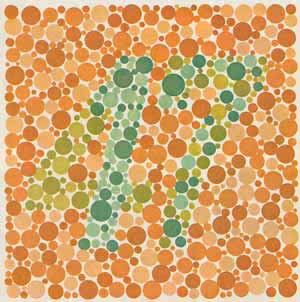Eye Conditions and Accessible Web Design
Published on Nov 21, 2006 (updated Oct 8, 2008), filed under development, accessibility. (Share this post, e.g. on Mastodon or on Bluesky.)
Accessibility on the Internet is by no means only about enabling people with eye diseases, however severe they may be, to access information. Nevertheless, this article deals exclusively with selected limitations of visual perception, with which it also aims to emphasize that blindness isn’t the only thing that needs to be addressed when developing accessible websites.
The author is not a doctor. For this reason, this article is kept brief and preferably refers to additional documents. Any mistakes will be corrected immediately. Please direct medical questions to a doctor you trust.
Contents
- Nearsightedness, Farsightedness, and Presbyopia
- Scotopic Sensitivity
- Color Vision Deficiency
- Retinitis Pigmentosa
- Photosensitive Epilepsy
- Color Blindness
- Summary
Nearsightedness, Farsightedness, and Presbyopia
Neither nearsightedness (myopia) nor farsightedness (hyperopia) nor presbyopia are diseases in the true sense, but they are widespread worldwide (DOC, 43 KB). All three of these impairments can usually be compensated for with glasses or contact lenses. But: A refractive error must first be noticed. So for all those whose website font size must not exceed ten pixels: Not everyone has eagle eyes.
- Prevalence:
- 15–25% nearsightedness (USA)), ~35% farsightedness (Spain), ~100% presbyopia from 40/45 years of age.
- Design measures:
- Not “too small” a default font size, scalable also in Internet Explorer (up to version 6).
As Jan Hellbusch notes, it’s important:
Those who need strong magnification will typically use a magnification system or screen magnifier—both [are] programs that enlarge a section of the screen. While screen magnifiers essentially work like a magnifying glass and display content in a movable window, magnification systems offer complex functions ranging from layout adjustment and color changes to supporting speech output.
However, not everyone with a visual impairment or visual disability needs strong magnification. Often a few smaller system adjustments are enough to be able to read the screen.
Scotopic Sensitivity
Scotopic sensitivity or Meares-Irlen syndrome is a light sensitivity problem diagnosed by Helen Irlen in 1983, which occurs primarily with black text on a white background. The symptoms, which can be observed both on paper and on monitors, include:
- The sensation that the page is too bright or glaring;
- Letters appear to move or blur;
- Contours or “rivers” appear in the text (“rivers of whitespace”).
The symptoms can not only make reading difficult, but can also cause headaches and a general reluctance to read.
- Prevalence:
- ~12%.
- Design measures:
- “Paler” background colors, weaker contrast.
Color Vision Deficiency
German Wikipedia previously said the following, here translated:
The terms red-green color vision deficiency and red-green color blindness are the scientific technical terms for over 99% of color vision deficiencies, which are colloquially referred to as color blindness. Those affected can distinguish the colors red and green less well than those with normal vision. This disability is caused by changes in the amino acid sequence in the visual pigment proteins (opsin) of the corresponding cones of the retina, which result from changes in the gene sequence of the corresponding opsin.
Known color vision deficiencies:
- Protanopia: Red blindness;
- Deuteranopia: Green blindness;
- Tritanopia: Blue blindness;
- Achromatopsia: Achromaticity (total color blindness).
Color vision deficiency is generally easy to accommodate by conveying information not only through color, but also through shape or labels. Additionally, it’s rarely a problem to avoid problematic color combinations altogether. Web designers can use various tools—such as Vischeck—to ensure that information offerings are adequately presented for those with color vision deficiencies.
Online, there is excellent background information on color vision deficiencies, including from Joe Clark, Wikipedia, Florida State University, and Terrace L. Waggoner.
- Prevalence:
- 4–5%.
- Design measures:
- Avoid corresponding color combinations and ensure color distinguishability.
Retinitis Pigmentosa
Color perception can generally be impaired with regard to contrast. Sufficient contrast should always be ensured for conveying information; this is obvious with (but not limited to) conditions like retinitis pigmentosa, where deteriorated contrast perception is one of the symptoms:
Retinitis pigmentosa refers to a group of hereditary eye diseases that result in the destruction of the retina. This currently incurable disease is still one of the most common causes of vision loss today. It is a hereditary disease that can be passed on to offspring.
Another essential symptom of retinitis pigmentosa is “tunnel vision,” so that only a small section of the displayed information is perceived on the screen. This requires orientation aids in the form of, for example, frames or clearly different background colors for individual areas of a document.
- Prevalence:
- 0.025–0.333%.
- Design measures:
- Stronger contrast, clearer delineation of page areas.
Photosensitive Epilepsy
Photosensitive epilepsy is a special form of epilepsy caused by flickering stimuli. According to studies, “flickering” at a frequency of 16 to 25 Hz can cause epileptic symptoms; other sources—as per Gez Lemon—even speak of a spectrum of 3 to 60 Hz.
- Prevalence:
- ~0.01% (~5% of those affected by epilepsy).
- Design measures:
- Avoid or minimize flickering areas.
Color Blindness
True color blindness (achromatopsia) is a rare genetic defect of the retina and manifests itself in the fact that those affected cannot perceive any colors at all. Nearly complete color blindness, photophobia, nystagmus (eye tremor), and reduced visual acuity are typical symptoms of color blindness.
- Prevalence:
- < 0.0001%.
- Design measures:
- Ensure color distinguishability, stronger contrast.
Summary
Even if this selection of limitations is not comprehensive—for the sake of simplicity, remarks on macular degeneration and Usher syndrome are missing entirely—it should become clear that limited visual perception, whether due to visual impairment or visual disability, does not only mean blindness. It should show that:
- far fewer people have “perfect” visual abilities than one might think;
- many perceptual problems are relatively easy to address, despite apparent conflicts (such as the contrast recommendations for scotopic sensitivity and retinitis pigmentosa).
Many thanks to Jan Hellbusch himself, who led the AG Sehbehinderte for many years.
About Me
I’m Jens (long: Jens Oliver Meiert), and I’m a web developer, manager, and author. I’ve been working as a technical lead and engineering manager for companies you’ve never heard of and companies you use every day, I’m an occasional contributor to web standards (like HTML, CSS, WCAG), and I write and review books for O’Reilly and Frontend Dogma.
I love trying things, not only in web development and engineering management, but also in other areas like philosophy. Here on meiert.com I share some of my experiences and views. (I value you being critical, interpreting charitably, and giving feedback.)

